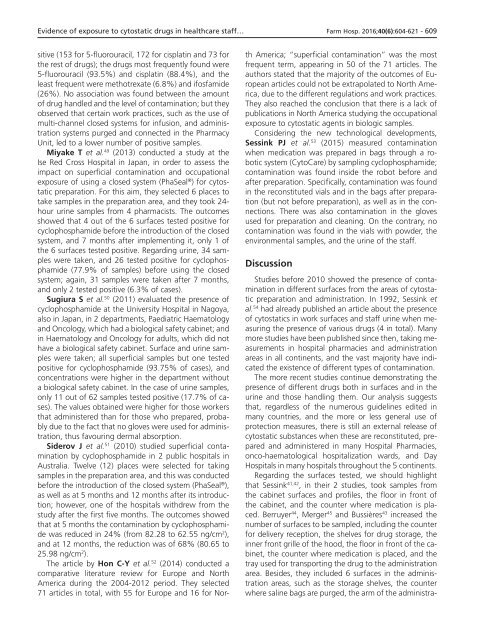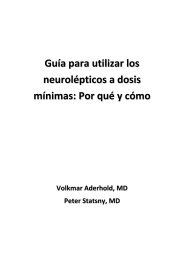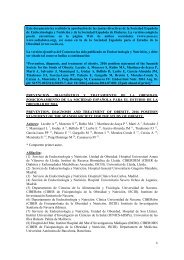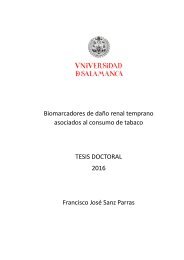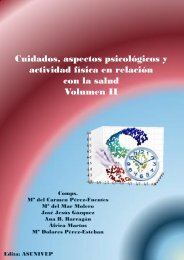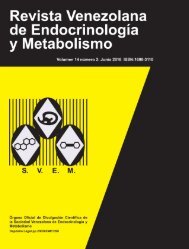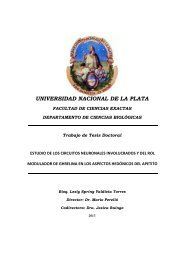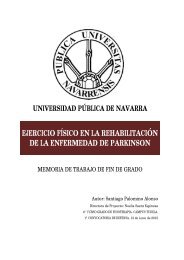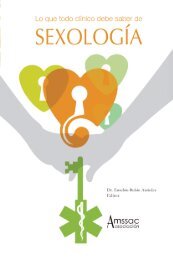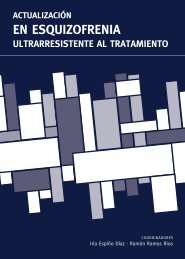Noviembre-Diciembre
156_v40n6(1)
156_v40n6(1)
Create successful ePaper yourself
Turn your PDF publications into a flip-book with our unique Google optimized e-Paper software.
Evidence of exposure to cytostatic drugs in healthcare staff… Farm Hosp. 2016;40(6):604-621 - 609<br />
sitive (153 for 5-fluorouracil, 172 for cisplatin and 73 for<br />
the rest of drugs); the drugs most frequently found were<br />
5-fluorouracil (93.5%) and cisplatin (88.4%), and the<br />
least frequent were methotrexate (6.8%) and ifosfamide<br />
(26%). No association was found between the amount<br />
of drug handled and the level of contamination; but they<br />
observed that certain work practices, such as the use of<br />
multi-channel closed systems for infusion, and administration<br />
systems purged and connected in the Pharmacy<br />
Unit, led to a lower number of positive samples.<br />
Miyake T et al. 49 (2013) conducted a study at the<br />
Ise Red Cross Hospital in Japan, in order to assess the<br />
impact on superficial contamination and occupational<br />
exposure of using a closed system (PhaSeal ® ) for cytostatic<br />
preparation. For this aim, they selected 6 places to<br />
take samples in the preparation area, and they took 24-<br />
hour urine samples from 4 pharmacists. The outcomes<br />
showed that 4 out of the 6 surfaces tested positive for<br />
cyclophosphamide before the introduction of the closed<br />
system, and 7 months after implementing it, only 1 of<br />
the 6 surfaces tested positive. Regarding urine, 34 samples<br />
were taken, and 26 tested positive for cyclophosphamide<br />
(77.9% of samples) before using the closed<br />
system; again, 31 samples were taken after 7 months,<br />
and only 2 tested positive (6.3% of cases).<br />
Sugiura S et al. 50 (2011) evaluated the presence of<br />
cyclophosphamide at the University Hospital in Nagoya,<br />
also in Japan, in 2 departments, Paediatric Haematology<br />
and Oncology, which had a biological safety cabinet; and<br />
in Haematology and Oncology for adults, which did not<br />
have a biological safety cabinet. Surface and urine samples<br />
were taken; all superficial samples but one tested<br />
positive for cyclophosphamide (93.75% of cases), and<br />
concentrations were higher in the department without<br />
a biological safety cabinet. In the case of urine samples,<br />
only 11 out of 62 samples tested positive (17.7% of cases).<br />
The values obtained were higher for those workers<br />
that administered than for those who prepared, probably<br />
due to the fact that no gloves were used for administration,<br />
thus favouring dermal absorption.<br />
Siderov J et al. 51 (2010) studied superficial contamination<br />
by cyclophosphamide in 2 public hospitals in<br />
Australia. Twelve (12) places were selected for taking<br />
samples in the preparation area, and this was conducted<br />
before the introduction of the closed system (PhaSeal ® ),<br />
as well as at 5 months and 12 months after its introduction;<br />
however, one of the hospitals withdrew from the<br />
study after the first five months. The outcomes showed<br />
that at 5 months the contamination by cyclophosphamide<br />
was reduced in 24% (from 82.28 to 62.55 ng/cm 2 ),<br />
and at 12 months, the reduction was of 68% (80.65 to<br />
25.98 ng/cm 2 ).<br />
The article by Hon C-Y et al. 52 (2014) conducted a<br />
comparative literature review for Europe and North<br />
America during the 2004-2012 period. They selected<br />
71 articles in total, with 55 for Europe and 16 for North<br />
America; “superficial contamination” was the most<br />
frequent term, appearing in 50 of the 71 articles. The<br />
authors stated that the majority of the outcomes of European<br />
articles could not be extrapolated to North America,<br />
due to the different regulations and work practices.<br />
They also reached the conclusion that there is a lack of<br />
publications in North America studying the occupational<br />
exposure to cytostatic agents in biologic samples.<br />
Considering the new technological developments,<br />
Sessink PJ et al. 53 (2015) measured contamination<br />
when medication was prepared in bags through a robotic<br />
system (CytoCare) by sampling cyclophosphamide;<br />
contamination was found inside the robot before and<br />
after preparation. Specifically, contamination was found<br />
in the reconstituted vials and in the bags after preparation<br />
(but not before preparation), as well as in the connections.<br />
There was also contamination in the gloves<br />
used for preparation and cleaning. On the contrary, no<br />
contamination was found in the vials with powder, the<br />
environmental samples, and the urine of the staff.<br />
Discussion<br />
Studies before 2010 showed the presence of contamination<br />
in different surfaces from the areas of cytostatic<br />
preparation and administration. In 1992, Sessink et<br />
al. 54 had already published an article about the presence<br />
of cytostatics in work surfaces and staff urine when measuring<br />
the presence of various drugs (4 in total). Many<br />
more studies have been published since then, taking measurements<br />
in hospital pharmacies and administration<br />
areas in all continents, and the vast majority have indicated<br />
the existence of different types of contamination.<br />
The more recent studies continue demonstrating the<br />
presence of different drugs both in surfaces and in the<br />
urine and those handling them. Our analysis suggests<br />
that, regardless of the numerous guidelines edited in<br />
many countries, and the more or less general use of<br />
protection measures, there is still an external release of<br />
cytostatic substances when these are reconstituted, prepared<br />
and administered in many Hospital Pharmacies,<br />
onco-haematological hospitalization wards, and Day<br />
Hospitals in many hospitals throughout the 5 continents.<br />
Regarding the surfaces tested, we should highlight<br />
that Sessink 41,42 , in their 2 studies, took samples from<br />
the cabinet surfaces and profiles, the floor in front of<br />
the cabinet, and the counter where medication is placed.<br />
Berruyer 44 , Merger 45 and Bussières 43 increased the<br />
number of surfaces to be sampled, including the counter<br />
for delivery reception, the shelves for drug storage, the<br />
inner front grille of the hood, the floor in front of the cabinet,<br />
the counter where medication is placed, and the<br />
tray used for transporting the drug to the administration<br />
area. Besides, they included 6 surfaces in the administration<br />
areas, such as the storage shelves, the counter<br />
where saline bags are purged, the arm of the administra-


